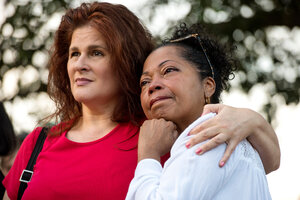A common thread in curbing racist expression
After the violence in Charlottesville, Va., Americans are seeking ways to curb public expressions of racism, from statues to tweets. One idea lies at the heart of these efforts.

Carol Leos embraces her friend Debbie Kirkland Waffer as they listen during a rally in Tyler, Texas, on Aug. 17. Around 75 people attended the rally to discuss ways the community could unify. The rally was held in response to the white nationalist rally held in Charlottesville, Va.
AP Photo
After last weekend’s violent protests in Charlottesville, Va., many Americans feel a need to make better choices about public expressions of racism, such as in Confederate symbols or hate-filled Facebook postings. The responses are quite diverse, ranging from the farcical to the coercive, which makes it important to look for a common thread that ultimately makes a difference.
In a “Saturday Night Live” skit, comedian Tina Fey urged Americans to respond to neo-Nazi hatred by ordering “a cake with the American flag on it ... and just eat it.” That is the “ignore it” response.
In contrast, HBO’s “Vice News Tonight” ran a half-hour documentary with an insider account of the white nationalist movement, showing vivid portrayals of the marchers in Charlottesville and their cause. The video has been viewed more than 36 million times. That is the “expose it” option.
Perhaps the easiest response comes from governments now questioning their past endorsements of racist expression in the public square. Dozens of cities and states are searching for Confederate memorials or signs erected decades ago and deciding whether to remove them. This is the “not in the public’s name” option. But this effort has its limits as many well-known figures in history are tainted by racism or who did good far beyond their errors.
Then there is the “disarm it” option, or taking away potential physical harm from racist expression. In Boston, for example, the city has ordered that an Aug. 19 rally by a right-wing group – and a counterprotest – not include sticks, guns, or anything that could be used as a weapon or to hide one. That rule is in contrast to the presence of guns and sticks – as well as a car used to strike counterprotesters – at the Virginia protests.
Boston’s protective action is similar to a new stance by the American Civil Liberties Union. The ACLU, in response to criticism of its usual defense of free speech, has decided not to defend the rights of hate groups if they allow guns at their rallies.
A variation of the ACLU’s response comes from internet companies such as Google and GoDaddy. Many high-tech firms are beefing up the policing of their websites for hate speech that might incite violence. As private companies, they can censor views in ways government should not. Yet in the era of democratized information, in which political and social groups have multiple digital platforms, this “private ban” option also has its limits. Big media are no longer the gatekeepers of public thinking.
A common thread in all these options is a heightened recognition of the need for individuals to stand guard over what ideas or images to allow into their thinking. The choices that Americans are now making about public expressions of hate and racism rely first and foremost on upholding the ability of everyone, either alone or through collective democratic means, to control what enters one’s consciousness.
This sounds so basic as to be trite, but it has been key over centuries in eroding the false claims about race. Keeping watch over one’s thinking also helps keep open the possibility for racists to realize they still have a choice and can question their views.
Racist groups often rely on intimidation to express themselves. Their rhetoric and rallies are often threatening and coercive. In contrast, those who guard their thoughts from racism rely on freedom of conscience and peaceful persuasion. And that option can make all the difference as the United States confronts the legacies and challenges of the notion that society define people by skin color.

